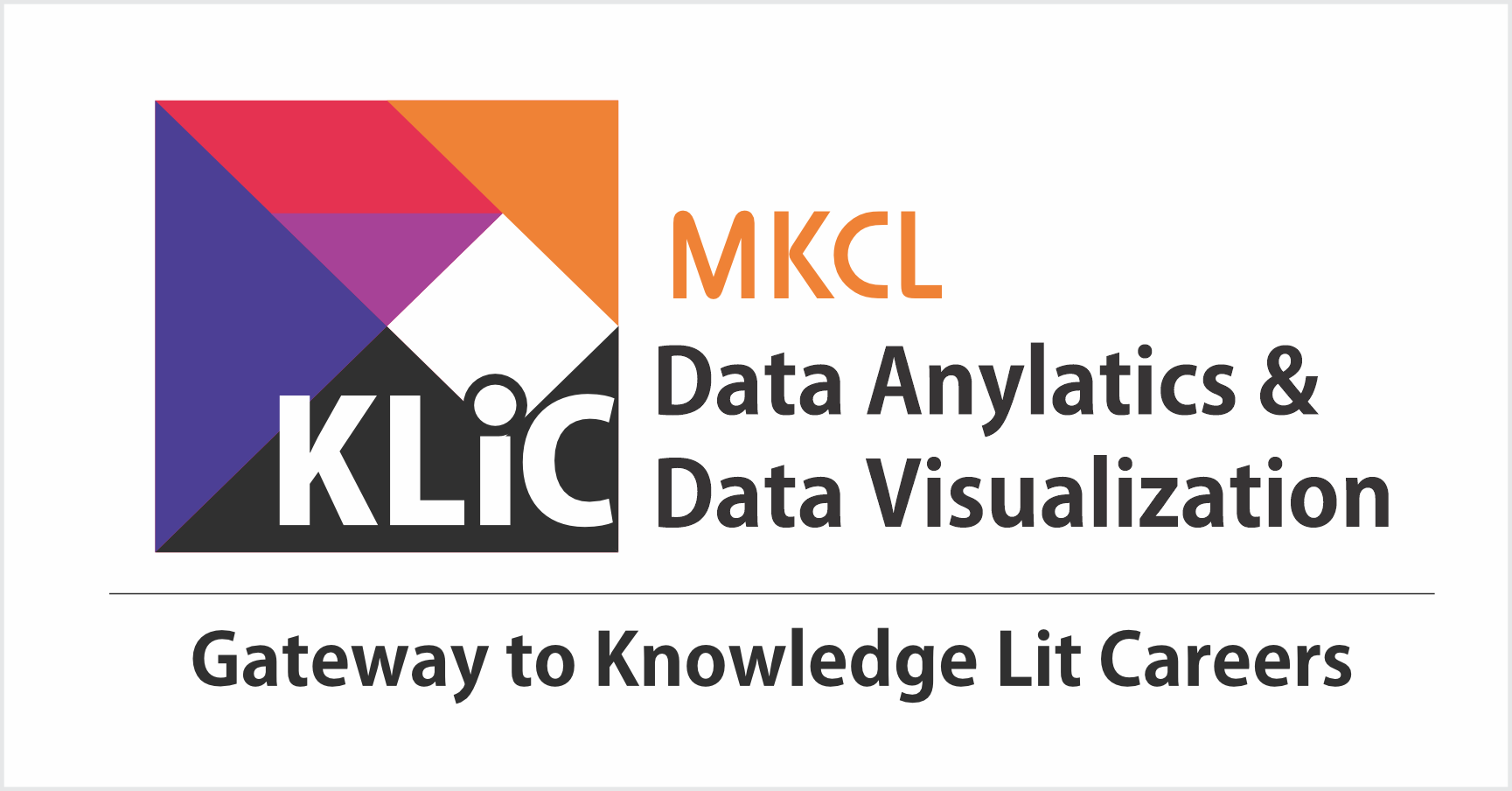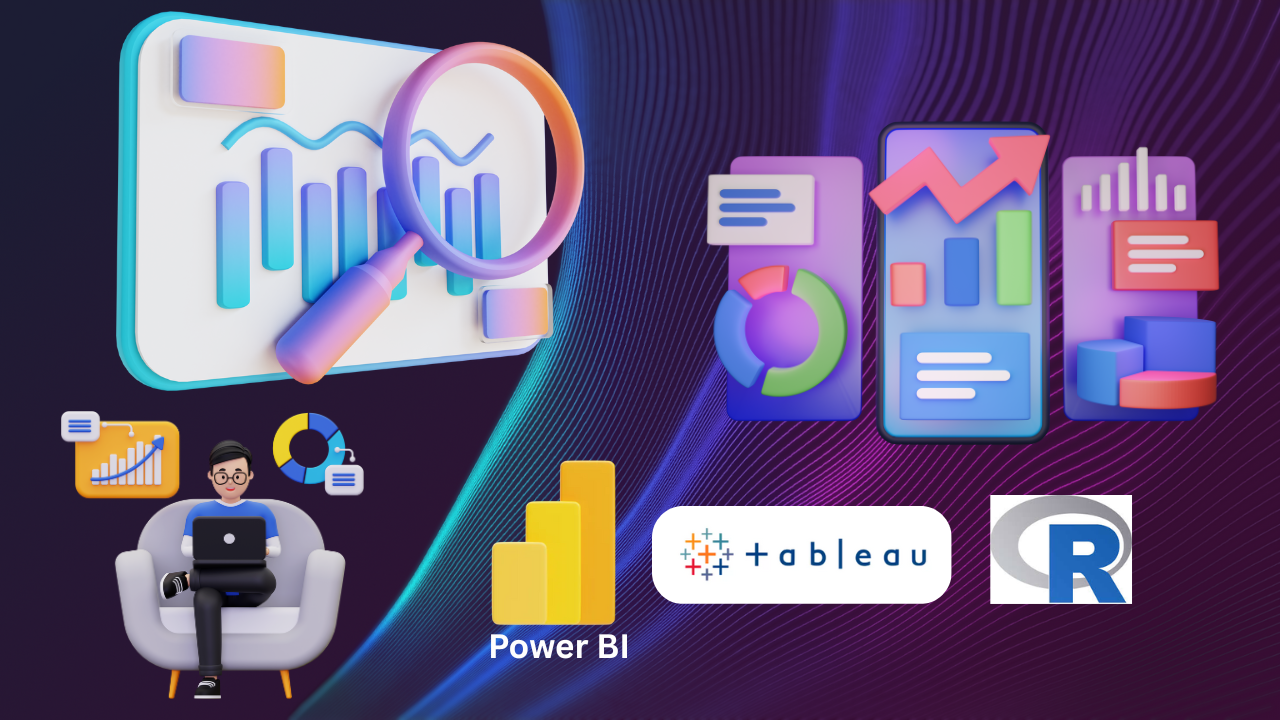- Develop foundational skills in Tableau for data visualization, including data import, integration, and exploration.
- Understand the concepts of dimensions, measures, and aggregations to create meaningful insights in Tableau.
- Learn to differentiate between discrete and continuous data and apply them effectively in visualizations.
- Gain proficiency in creating various types of charts, graphs, and dashboards for data storytelling in Tableau.
- Understand and implement different types of filters in Tableau to refine data analysis and reporting.
- Develop a strong foundation in Python, including data types, control structures, and functions.
- Apply Python for data manipulation, file handling, and error handling in real-world scenarios.
- Gain hands-on experience in SQL database management, including data retrieval, modification, and transactions.

Advanced Visualization Techniques and Python Fundamentals
Learn Python basics with a focus on data visualization. Build interactive charts and explore libraries like Matplotlib and Seaborn.
Introduction
What you'll learn ?
- Demonstrate competence in Tableau by creating insightful visualizations and dashboards for data-driven decision-making.
- Use Python for data processing, analytics, and visualization, incorporating real-world datasets.
- Perform SQL database operations for structured data management and retrieval.
Syllabus
- Tableau: A Data Visualization Tool
- Exploring Data with Tableau
- Tableau Desktop and Tableau Public
- Tableau Public Installation and Interface Exploration
- Data Import and Exploration in Tableau
- Efficient Data Integration: Excel Sheets in Tableau for Analysis
- Introduction to Data Exploration in Tableau Public
- Sheet Connections in Tableau Public
- Pricing Structure for Tableau
- Sources of Data in Tableau
- Understanding Dimensions and Measures in Tableau
- Dimensional Analysis - Insights in Tableau
- Distinguish Discrete and Continuous in Tableau
- Discrete vs. Continuous
- An Example using Dimensions and Measures in Tableau
- Data Aggregations in Tableau
- Advanced Measures Exploration in Tableau
- Visualize with Tableau - Charts and Graphs
- Advanced Chart Creation in Tableau
- Tableau Public - Profile, Interactions, and Sharing
- Creating, Customizing, and Managing Reports in Tableau
- Exploring and Customizing Bar Charts in Tableau
- Measures for Customizing Bar Chart Labels in Tableau
- Construct Stacked Bar Charts for Deeper Insights
- Creating Continuous Line Charts with Tableau
- Crafting and Customizing Line Charts in Tableau
- Exploring Scatter Plots in Tableau
- Advanced Techniques for Scatter Plots and Circle Views in Tableau
- Create Dual Axis Charts for Comparative Analysis
- Dual and Combined Axes in Tableau
- Customizing Dual and Combined Axes
- Designing and Crafting Funnel Charts in Tableau
- Funnel Formatting and Final Touches
- Create Crosstabs for Data Comparison
- Develop Highlight Tables for Enhanced Visualization
- Modify Column Data Types for Accurate Analysis
- Manage Data: Renaming, Hiding, and Sorting
- Set Default Field Properties for Efficiency
- Implement Dimension Filters for Focused Analysis
- Apply Date Filters for Temporal Data Analysis
- Utilize Measure Filters for Quantitative Analysis
- Crafting Visualizations and Dashboards in Tableau
- Introduction to Action Filters in Tableau
- Create Interactive Filters for Dynamic Insights
- Apply Data Source Filters for Streamlined Data
- Context Filters for Targeted Insights in Tableau
- Calculated Fields and Top N Filters in Tableau
- Diverse Visualizations and Dashboard Layouts in Tableau
- Applying Filters and Adding Visualizations in Tableau
- Enhancing Visualizations with Action Filters in Tableau
- Advanced Action Filters in Tableau
- What can Python do?
- Why Python?
- Python Installation
- Print Statement with Multiple Techniques
- Displaying Name and Age with the format() Method
- Understanding and Utilizing Different Types of Comments
- Multi-line and DocString Comments
- Strings, Numeric, and Complex Data Types
- Lists, Tuples, Ranges, and Dictionaries in Python
- Indexing, Slicing, and Essential Methods
- String Functions and Boolean Operations
- Sets, Frozen Sets and Booleans in Python
- Understanding Byte, ByteArray, and Memory View
- Python Handling User Input with Ease
- Operations and Tuple Modifications
- Arithmetic and Assignment Operators
- Comparison and Logical Operators
- Understanding Rules and Examples for Python Indentation
- Structure in Loops
- Conditional Statements in Python
- Simple If and If-Else Statements
- Advanced If-Else and Nested IFs
- An Example with If and Its Related Statements
- Python's While Loops
- Infinite Loops and Break Statements
- Python's For Loop
- For Loops with Dictionaries and Sets
- Python's Range Function Basics
- Advanced Techniques for Range Functions
- Break & Continue
- Assert
- Python Looping Essentials
- Advanced Looping Techniques in Python
- Create a Function
- Function Type
- Fundamentals of Variable Arguments in Python Functions
- Advanced Applications of Variable Arguments in Python
- Scope of a Function
- Function Documentations
- Lambda Functions & Map
- Basics to Advanced Applications in Python
- Functions for String Manipulation and Data Types
- Create a Module
- Python's Standard Math Modules
- Time with Standard Modules
- Local to Global Variables in Python
- Advanced Local and Global Variables
- Python Errors - From Syntax to Runtime
- Error Handling in Python
- Python Exception Handling
- Type Errors and Custom Solutions
- File Handling - Reading, Writing, and Appending
- File Handling - Modes, Closing, and Best Practices
- Custom Exceptions in Python
- Implementing and Utilizing Custom Exceptions
- Python File Reading Essentials
- Reading and Analyzing Words and Lines in Python
- New-Style Classes in Python
- Python's Class Hierarchy and Inheritance
- Creating Classes
- Instance Methods
- Inheritance in Python - Foundation of Superclass
- Subclassing and Method Overriding
- Polymorphism
- Python Exception Handling - Basics
- Creating and Utilizing Custom Exceptions in Python
- Namedtuple
- Operations, Instantiation, and Advanced Features
- Rotations and Element Access in Python
- Accessing and Modifying Mappings
- Custom ChainMap Class in Python
- Counter
- OrderedDict
- Defaultdict
- UserDict, UserList, and UserString
- Introduction and Installation
- DB Connection
- Getting Started with MySQL
- Crafting Tables in MySQL
- Inserting Data into MySQL Tables
- Reading, Updating, and Deleting Data in MySQL
- COMMIT & ROLLBACK operation
- MySQL Error Handling
- Handling Errors in MySQL Operations
- An Introduction to Built-in Iterators
- Custom Iterators for Squares
- Range-like Iterators
- Sleep
- Techniques for Measurement in Python
- Calculating Execution Time with Python's timeit and time Module
- Time Representation in Python
- Creation to Arithmetic Operations
- Data Filtering in Python
- Filtering Non-Empty Strings and Unique Emails
- Python's map, filter, and reduce
- Python's map and star map for Enhanced Functionality
- Reduce
- Basic Decorators Functionality
- Decorators for Enhanced Functionality
- Frozen set
- Python's Collections Module and Its Core Components
- Collections for Enhanced Data Handling and Manipulation in Python
- Python String Manipulation
- Handling Whitespace and Delimiters with Split()
- Identifying Various Date Formats in Python
- Email Validation with Regular Expressions in Python
- Power of Quantifiers in Regular Expressions
- Lazy and Non-Greedy Quantifiers in Regular Expressions
- Exploring Match, Search, and Fullmatch in Python
- Leveraging find all and finditer Functions in Python
- Search, Substitute, and Named Groups
- Search and Substitute Functions with Regular Expressions
- Advanced Replacement Techniques with sub N Function and Practical Examples
- Exploring Patterns, Classes, and Case-Insensitive Matching in Python
- Ranges, Delimiters, and Specific Patterns in Python
- Exploring Character Classes and Search Methods in Regular Expressions
- Managing Special Characters with Escape Sequences and Anchors
Certificate
- MKCL provides certificate (for 30/60/90 hours courses) to the KLiC learner after his/her successful course completion.
Academic Approach
The Academic Approach of the course focuses on the “work centric” education i.e. begin with work (and not from a book !), derive knowledge from work and apply that knowledge to make the work more wholesome, useful and delightful. The ultimate objective is to empower the Learner to engage in socially useful and productive work. It aims at leading the learner to his/her rewarding career as well as development of the society.
Learning methodology
- Learners are given an overview of the course and its connection to life and work.
- Learners are then exposed to the specific tool(s) used in the course through the various real-life applications of the tool(s).
- Learners are then acquainted with the careers and the hierarchy of roles they can perform at workplaces after attaining increasing levels of mastery over the tool(s).
- Learners are then acquainted with the architecture of the tool or Tool Map so as to appreciate various parts of the tool, their functions and their inter-relations.
- Learners are then exposed to simple application development methodology by using the tool at the beginner’s level
- Learners then perform the differential skills related to the use of the tool to improve the given ready-made outputs.
- Learners are then engaged in appreciation of real-life case studies developed by the experts.
- Learners are then encouraged to proceed from appreciation to imitation of the experts.
- After imitation experience, they are required to improve the expert’s outputs so that they proceed from mere imitation to emulation.
- Finally, they develop the integral skills involving optimal methods and best practices to produce useful outputs right from scratch, publish them in their ePortfolio and thereby proceed from emulation to self-expression.
Evaluation Pattern
Evaluation Pattern of KLiC Courses consists of 4 Sections as per below table:
| Section No. | Section Name | Total Marks | Minimum Passing Marks |
|---|---|---|---|
| 1 | Learning Progression | 25 | 10 |
| 2 | Internal Assessment | 25 | 10 |
| 3 | Final Online Examination | 50 | 20 |
| Total | 100 | 40 | |
| 4 | SUPWs (Socially Useful and Productive Work in form of Assignments) | 5 Assignments | 2 Assignments to be Completed & Uploaded |
MKCL’s KLiC Certificate will be provided to the learner who will satisfy the below criteria:
- Learners who have successfully completed above mentioned 3 Sections i.e. Section 1, Section 2 and Section 3
- Additionally, learner should have completed Section 4 (i.e. Section 4 will comprise of SUPWs i.e. Socially Useful and Productive Work in form of Assignments)
- Learner has to complete and upload minimum 2 out of 5 Assignments
Courses Fee Structure from 01 July, 2025 Onwards
KLiC 30 hour course fee applicable from 01 July, 2025 all over Maharashtra| KLiC Course Duration | MFO: MKCL Share (Including 18% GST) |
ALC Share (Service Charges to be collected by ALC) |
|---|---|---|
| 30 hours | Rs. 300/- | Rs. 1,500/- |
Important Points:
* Above mentioned fee is applicable for all Modes of KLiC Courses offered at Authorised Learning Center (ALC) and at Satellite Center
* Total fee is including of Course fees, Examination fees and Certification fees
* MKCL reserves the right to modify the Fee anytime without any prior notice
* Above mentioned fee is applicable for all Modes of KLiC Courses offered at Authorised Learning Center (ALC) and at Satellite Center
* Total fee is including of Course fees, Examination fees and Certification fees
* MKCL reserves the right to modify the Fee anytime without any prior notice
